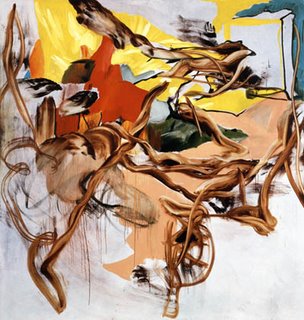Gap Jujitsu: The Power of Having an Inside And An Outside... Probably Part One of ???

Warning: unformed thoughts ahead! I've been meaning to write about this paragraph, attributable to Jerry Saltz, for awhile now:
There’s a new psycho-social space, mainly American, that increasing numbers of artists are probing. Painter Charlene von Heyl has put it this way: "While almost everything in the outer world feels messed-up our inner lives aren’t altogether messed-up." This paradoxical disconnect is neither a state of denial nor one of enlightenment. It is extremely palpable, however, and may help explain why so many Americans are taking prescribed psychoactive drugs when, really, they’re only having reasonable reactions to the echo chamber of information and images that reduces everything to a squalid pseudo-narrative of garbage. Whatever’s happened, Robert Rauschenberg’s famous "gap between art and life" has turned into a new vividly dissonant gap between inner and outer life.
And I have not quite managed to push my fist-pumping and my outrage together into one cohesive nugget. On one hand, this difference between inside and outside is such rich terriain. But what is being said here? I keep falling back on the weakest words... like should. It is so easy to say that Saltz should see that this disconnect is absolutely the same as denial; that artists should be charging into that "vividly dissonant gap"--that this gap should be more fun to explore than one's own backyard of the known.
Yeah. This is the problem with the word should. What a thought-flattener. It turns whatever you were thinking into grousing, and it denies what actually exists. The space that Saltz is pointing out is interesting--it has the potential to be powerful. And I like that he's using von Heyl's powerful, body-based approach to begin talking about what he is calling a psycho-social space, but I would call a path toward really good stuff. That disconnect between inner space and outer space is what gives you the power to make disasters into challenges. That disconnect is mind over matter--it's what gives the mountain climber the strength to reach the top, and it's the platform off which intellectuals leap. It's the fucking foundation of visionary thinking.
For this reason, I disagree with Saltz's assesment that this disconnect is neither a state of denial nor a state of enlightenment. It's both! Just as this disconnect gives the thinking person the power to see a problem in its entirety and apart from oneself (and I would think of this position as an enlightened one), it also gives junkies and their codependent families the power to keep each junky addicted. This disconnect gives you the power to go ahead and buy new huge Range Rover and at the same time talk about your commitment to the environment. This disconnect between inside and outside is inherently human--it is not a new feature of the American landscape. But it is increasingly relevant, as we all watch a Bush Administration in denial create a horrifying bloodbath in the Middle East.
The presence of the disconnect is not the point. It's what is being done with it that's interesting. Saltz goes on in his review to use the word truth:
In this imperfect realm we experience the undeniable, elemental truth that sometimes, just by making or looking at art, we might discern the full range of human possibilities.
And yeah, this is where I would go next as well. Funny things happen to the word truth when you start thinking about it in terms of this disconnect. Objectivity disappears, but other kinds of shared terrain become more visible. But man... That's another post.

1 Comments:
Thanks for the excellent post, Deborah. I really enjoy your writing here.
I've posted a brief response to you and Saltz on my blog, here.
Post a Comment
<< Home